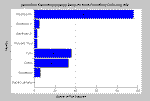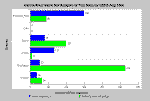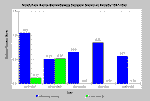Bibliography Background About KRIS
Hypothesis #1: The abundance and distribution of coho salmon in the Garcia River basin have been reduced.
Support for the Hypothesis
Historic accounts (Shapovalov, 1948 as cited in CDFG, 1956; CDFG, 1968; CDFG, 1978) of coho salmon distribution and relative abundance and recent coho adult (Nielsen et al., 1991; Maahs, 1996, 1997, 1999; Maahs and Barber, 2001) and juvenile (NMFS, 2000) surveys provide support for this hypothesis.
The California Department of Fish and Game (1978) estimated the annual adult return of coho salmon at2,000 and the adult steelhead population at 4,000 for the Garcia River in the early 1960's (table). Although the California Department of Fish and Game did not conduct coho salmon population surveys in the Garcia River, Shapavalov (1948 as cited in CDFG, 1956) saw schools of coho salmon juveniles in the upper reaches of the river below an impassable falls near the old Point Arena Hot Springs. He described the Garcia River below the falls as a "beautiful stream for the mile seen below the falls, with a good combination of excellent spawning riffles and deep pools, and stretches of rough, boulder- and rubble-strewn water…... Steelhead and silver salmon 2 to 3 1/3 inches ... abundant everywhere, many in schools of a few to several dozen fish.” The Garcia River Watershed Enhancement Plan (Mendocino County RCD, 1992) noted that coho salmon extended their range up into Pardaloe Creek after an impassable waterfall was blasted in 1964.
Kimsey (CDFG, 1953) found the mainstem Garcia River to be dominated by salmonids and even found coho juveniles below the North Fork. He electrofished reaches of the Garcia, Navarro and Gualala rivers to find evidence as to whether these streams could sustain summer "trout" fishing without damaging salmon and steelhead runs. In his August 1952 samples, coho salmon juveniles were collected in the mainstem below the North Fork and older age classes of steelhead were also present (Figure 1). Pister (1965) also found coho salmon juveniles to be abundant in the South Fork Garcia in 1955 electrofishing surveys, in work related to the same study.
 Figure 1. This chart shows California Department of Fish and Game electrofishing samples on the mainstem Garcia River below the North Fork collected in August 1952. The survey showed a community dominated by steelhead and coho with a lesser number of sculpin (Cottids) and stickleback. The presence of older age steelhead and coho are indicative of high quality aquatic habitat conditions with deep pools and very cold water. Resident trout were fish over eight inches in length. Data from CDFG (1953).
Figure 1. This chart shows California Department of Fish and Game electrofishing samples on the mainstem Garcia River below the North Fork collected in August 1952. The survey showed a community dominated by steelhead and coho with a lesser number of sculpin (Cottids) and stickleback. The presence of older age steelhead and coho are indicative of high quality aquatic habitat conditions with deep pools and very cold water. Resident trout were fish over eight inches in length. Data from CDFG (1953).
By 1968, salmonids shared the mainstem Garcia with many more native suckers, indicating a profound change in conditions after the 1955 and 1964 floods. German (CDFG, 1968) explored complaints of local residents and anglers that suckers had come to dominate the Garcia River and displaced salmonids after the 1955 and 1964 floods. His fish collections using a seine net indicate that the mainstem had a large number of suckers and no coho (Figure 2). The warm water species domininance was likely linked to warming of the Garcia River as it was filled in by sediment from Post WW II logging and the 1955 and 1964 floods.
 Figure 2. This chart shows fish captured in the mainstem Garcia River above Highway 1 and above Eureka Hill Bridge in August 1968 by the California Department of Fish and Game. The seine net samples indicate a fish community dominated by steelhead above Highway 1, with suckers present, while the Eureka Hill bridge site yielded a sample dominated by suckers and stickleback. The high number of suckers and stickleback would be consistent with a a stream that had warmed. Data from CDFG (1968).
Figure 2. This chart shows fish captured in the mainstem Garcia River above Highway 1 and above Eureka Hill Bridge in August 1968 by the California Department of Fish and Game. The seine net samples indicate a fish community dominated by steelhead above Highway 1, with suckers present, while the Eureka Hill bridge site yielded a sample dominated by suckers and stickleback. The high number of suckers and stickleback would be consistent with a a stream that had warmed. Data from CDFG (1968).
With regard to coho, German (CDFG, 1968) asserted that “the Garcia River has lost much of its ability to serve as a spawning and nursery stream. This is undoubtedly due to the logging in the area. Since the small tributaries have been damaged, the Garcia has also been damaged. We found no silver salmon in the river above the Smith Fork nor in any of the tributaries in this area which would lead one to believe these fish are no longer able to sustain themselves in the Garcia System.”
The adult coho salmon population in the Garcia River basin has been extremely low since 1990 as indicated by adult salmonid redd counts and carcass surveys (Nielsen et al., 1991; Maahs, 1997; Maahs, 1999; Maahs and Barber, 2001). No coho redds or live adult coho were seen; however, one coho carcass was found in 1995 (Maahs, 1996).
Juvenile salmonid survey data also confirm the rarity of coho salmon juveniles in the Garcia River basin. The California Department of Fish and Game found coho in the South Fork Garcia River in 1987 and 1988 but not in 1989, 1991 and 1992 (Figure 3) during electrofishing surveys (NMFS, 2000). This was despite CDFG planting coho salmon in the South Fork in 1985 and 1988 (Adams et al., 1999).
 Figure 3. California Department of Fish and Game staff electrofished the South Fork Garcia to survey anadromous salmonids from 1987 to 1992. Coho salmon and steelhead densities are displayed above for all years. Juvenile coho were present in both 1987 and 1988 samples, but not thereafter, with densities of 0.12 and 0.52 coho per square meter in each year, respectively. Data from Wendy Jones, CDFG retired.
Figure 3. California Department of Fish and Game staff electrofished the South Fork Garcia to survey anadromous salmonids from 1987 to 1992. Coho salmon and steelhead densities are displayed above for all years. Juvenile coho were present in both 1987 and 1988 samples, but not thereafter, with densities of 0.12 and 0.52 coho per square meter in each year, respectively. Data from Wendy Jones, CDFG retired.
The California Department of Fish and Game (2002) coho salmon status review noted the following: "Recently, coho salmon have been either completely absent or have been represented very sporadically within the Whale Gulch, Jackass (Wolf), Usal, Hardy, Juan, Russian Gulch, Buckhorn, Greenwood, Mallo Pass, Elk, Brush, Garcia, Schooner Gulch, or Fish Rock Gulch watersheds." All CDFG and NMFS surveys since 1988 have confirmed coho presence only in the North Fork and South Fork Garcia rivers. However, Brown and Moyle (1991) note that CDFG biologists "indicated that a small, remnant run persists somewhere in the Garcia River though the number and location of spawners is unknown". The latter finding is why the mainstem Garcia River is shown as sometimes having coho in the map below (Figure 4).
 Figure 4. This map showing presence and absence of coho salmon since 1988 illustrates that coho distribution in the Garcia River basin is patchy. The North Fork showing coho always present is the result of only one survey in 2002. Data sources include Brown and Moyle (1991), Adams et al. (1999), NMFS (2000) and data collected by CDFG pursuant to its coho status review (CDFG, 2002). From the KRIS Garcia Map project and database.
Figure 4. This map showing presence and absence of coho salmon since 1988 illustrates that coho distribution in the Garcia River basin is patchy. The North Fork showing coho always present is the result of only one survey in 2002. Data sources include Brown and Moyle (1991), Adams et al. (1999), NMFS (2000) and data collected by CDFG pursuant to its coho status review (CDFG, 2002). From the KRIS Garcia Map project and database.
The following is a list of Topics in KRIS Garcia where you can see data in its context, Metadata and associated Info Links. The large-case letters in parentheses indicate KRIS sub-basins.
(LG) Fish: 1952 Kimsey Electrofishing Garcia River Site #3, CDFG
(LG) Fish: 1968 Net Sampling Garcia River Above Highway 1/Eureka Hill, CDFG
(SF) Fish: SF Garcia Salmonid Density 1987-1992
(BW) Fish: Presence/Absence of Coho in KRIS Garcia Project Area 1988-1999 (*select theme with 1988-2002)
Alternate Hypothesis
The observed change in the distribution and abundance of coho and steelhead is within the natural range of variability.
Ocean conditions and fishing are known to have caused variable ocean survival off the Pacific Northwest coast with attendant cycles in abundance for coho salmon (Finney et al., 2000). See Higgins (1997) for a fuller discussion of potential impacts of these factors on regional fish stocks, including the Garcia. Given the lack of long term trend data for adult coho salmon, some contend that a decline in the species can not actually be established (Ellis, 1997).
Monitoring Trends to Test the Hypotheses
To see if salmon and steelhead populations are, indeed, just in natural remission and will rebound in the future, fish surveys like spawner and redd counts, creel census, downstream migrant trapping and more widespread electrofishing should be conducted. In particular, the mainstem Garcia River below the North Fork should be monitored to see if coho salmon juveniles recur as stream temperatures cool and pools grow deeper in response to watershed rest and restoration efforts.
Note: There is evidence that could be presented that the Garcia River once harbored three or four species of Pacific salmon, including chinook salmon (MCRCD, 1992) and pink salmon (Holmes, 1938), but corollary scientific evidence was insufficient for robust support.
References
Adams, P.B., M.J. Browers, H.E. Fish, T.E. Laidig and K.R. Silberberg. 1999. Historical and Current Presence-Absence of Coho Salmon (Oncorhynchus kisutch) in the Central California Coast Evolutionarily Significant Unit. Administrative Report SC-99-02. NOAA Southwest Fisheries Science Center, Tiburon, CA. 28 p.
Brown, L.R. and P.B. Moyle. 1991. Status of Coho Salmon in California. Report to the National Marine Fisheries Service. Department of Wildlife and Fisheries Biology, University of California, Davis, CA. 95616. 89 p.
California Department of Fish and Game (CDFG). 1953. Population sampling on three north coastal streams closed to summer trout fishing - 1952 season. First progress report. Written by J.B. Kimsey. CDFG, Inland Fisheries Branch. Yountville, CA. 28 pp. [298kb]
California Department of Fish and Game (CDFG). 1956. Various field notes concerning the Garcia River and tribs, from Leo Shapovalov in 1948 to Holman who recapped in this memo. CDFG. Yountville, CA. 2 pp. [98kb]
California Department of Fish and Game (CDFG). 1968. Memorandum regarding the presence of suckers in Garcia River, 28 August 1968. CDFG unpublished file memo by E. German. Yountville, CA. 2 pp. [16kb]
California Department of Fish and Game. 1978. The status of salmon populations in California coastal rivers. By S.N. Taylor, California Department of Fish and Game, Salmon/Steelhead Program, Anadromous Fisheries Branch, Sacramento, CA. 14 pp.
California Department of Fish and Game (CDFG). 2002. Status review of California coho salmon north of San Francisco: Report to the California Fish and Game Commission. CDFG. Sacramento, CA. 336 pp. [6.9Mb]
Ellis, R. H. 1997. Comments to National Marine Fisheries Service regarding the proposed listing of coho salmon as threatened in the Southern Oregon/Northern California ESU. Submitted on behalf of: California Forestry Association and California Forest Resources Council, Sacramento, CA. 41 p.
Finney, B.P., I. Gregory-Evans, J. Sweetman, M.S. Douglas, J.P. Smol. 2000. Impacts of Climatic Change and Fishing on Pacific Salmon Abundance Over the Past 300 Years. Science. 2000, Oct 27; 290 (5492):795-799.
Higgins, P.T. 1997. Gualala River Watershed Literature Search and Assimilation. Funded by the Coastal Conservancy under contract to Redwood Coast Land Conservancy. Gualala, CA. 59 pp.
Holmes, O. 1937. Letter to A.C. Taft regarding hump back salmon, dated November 8th, 1937. (California) Department of Natural Resources, Division of Fish and Game. Yountville, CA. 2 pp. [12kb]. See also: California Division of Fish and Game (1937).
Maahs, M. [1996]. A salmon spawning survey for portions of Ten Mile, Caspar Creek and Garcia River. 1995-96. Prepared for Humboldt County Resource Conservation District. Salmon Trollers Marketing Association, Inc. Fort Bragg, CA. 31 pp. [381kb] **
Maahs, M. [1997]. The 1996-97 salmonid spawning survey for portions of the Ten Mile River, Garcia River and Caspar Creek. Prepared for Humboldt County Resource Conservation District . Salmon Trollers Marketing Association, Inc . Fort Bragg, CA. 31 pp. [388kb] **
Maahs, M. 2000. Spawning survey of the Garcia River, 1998-99 . Prepared for Mendocino County Resources Conservation District and California Department of Forestry and Fire Protection. . Ukiah, CA. 11 pp. [107kb] **
Maahs, M. and T. J. Barber. 2001. The Garcia River instream monitoring project. Final report to California Department of Forestry and Fire Protection. Mendocino County Resources Conservation District. Ukiah, CA. 104 pp. [750kb]
Mendocino County Resource Conservation District (MCRCD). 1992. Garcia River Watershed Enhancement Plan. Prepared for the California State Coastal Conservancy. Prepared by MCRCD, written by Jack Monschke and D. Caldon, Kier Associates. Ukiah, CA. 207 pp. [3.1Mb]**
National Marine Fisheries Service. 2000. Draft: California coastal salmon and steelhead current stream habitat distribution table for Mendocino County . Produced for National Marine Fisheries Service, Southwest Region by Wendy Jones, CDFG retired. 127 pp. [360kb]
Nielsen, J. L., M. Maahs, and G. Balding. 1990. Anadromous salmonid resources of Mendocino coastal and inland rivers 1989-90. An evaluation of rehabilitation efforts based on carcass recovery and spawning activity. Report submitted to California Dept. of Fish and Game. Fisheries Restoration Program, Work Progress Report 1990. 98p.
Pister, E.P. 1965. Population sampling of three north coastal streams closed to summer trout fishing - 1955 season. CDFG In. Fish. Admin. Rept. 65-12. 8 pp.